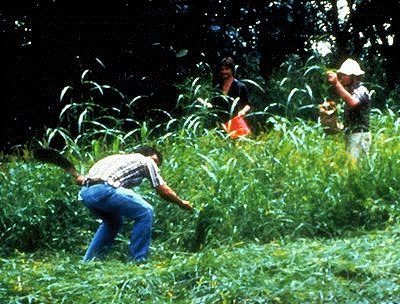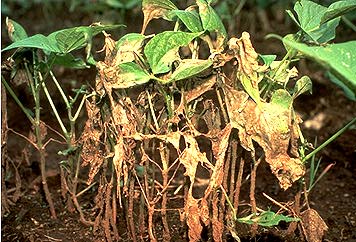
Frijol Tapado System

Broadcasting beans and slashing weeds and grasses for frijol tapado (Picture courtesy of José Galindo)
Traditional farmers in many areas of Costa Rica grow beans (Phaseolus vulgaris) using a slash/mulch system called in Spanish "frijol tapado", which in English means "covered beans." The procedure consists of broadcasting bean seeds into carefully selected weeds, then cutting and chopping the weeds with a machete so the broadcasted bean seeds are covered with a mulch of weeds. A semi-determinate type of bean, between a bush and a climbing bean, is planted. The beans grow through the mulch and eventually cover it. This combination of mulch and bean plants effectively prevents weed growth and appears to conserve soil moisture. In addition, the mulch prevents soil splashing, which was found in a Costa Rican study by Galindo et al. to be the most important source of inoculum of Thanatephorus cucumeris causing a severe bean disease called web blight. The fields selected for tapado are generally occupied by broadleaf weeds and certain grasses, which will not regrow after they are cut. Thus the weeds do not compete with the beans for light, nutrients, or moisture. The disease is effectively managed by traditional farmers who use the traditional practice of frijol tapado, even in areas where climate is optimal for web blight development.
Frijol tapado field shortly after planting (note palm tree - upper left) (Picture courtesy of José Galindo)
Same frijol tapado field a few weeks after planting (note palm - upper left). Weeds are smothered. (Picture courtesy of José Galindo)
Beans emerging through mulch produced in frijol tapado field. (Picture courtesy of José Galindo)
Frijol tapado fields on extremely steep slopes in San Ignacio de Acosta, Costa Rica (Picture courtesy of Ramiro de la Cruz)
 Steep
hill in Honduras with beans and maize in tapado system
Steep
hill in Honduras with beans and maize in tapado system
Web blight of beans (Picture courtesy of José Galindo)
 Web blight
of beans is caused by the fungus Thanatephorus cucumeris (anamorph
-- Rhizoctonia solani ). In the humid lowlands of the tropics, web
blight is possibly the single most destructive disease of beans. Beans are
traditionally grown in cooler, temperate areas in Latin America, but because
of population pressures, farmers migrate from high to low-altitude areas
and often take beans with them. In warm and humid tropical areas T.
cucumeris can cause rapid defoliation of beans and sometimes complete
crop failure. In 1980, an epidemic of web blight occurred in the Guanacaste
region in the northern part of Costa Rica, resulting in a 90% reduction in
bean yields. This loss occurred on beans planted under clean cultivation.
As with many tropical diseases, precise information on yield losses is difficult
to obtain, but the disease has been characterized as severe in Mexico, Costa
Rica, and elsewhere in Latin America. The main sources of inocula that can
initiate infection are mycelial fragments and sclerotia (fungal resting bodies).
Web blight
of beans is caused by the fungus Thanatephorus cucumeris (anamorph
-- Rhizoctonia solani ). In the humid lowlands of the tropics, web
blight is possibly the single most destructive disease of beans. Beans are
traditionally grown in cooler, temperate areas in Latin America, but because
of population pressures, farmers migrate from high to low-altitude areas
and often take beans with them. In warm and humid tropical areas T.
cucumeris can cause rapid defoliation of beans and sometimes complete
crop failure. In 1980, an epidemic of web blight occurred in the Guanacaste
region in the northern part of Costa Rica, resulting in a 90% reduction in
bean yields. This loss occurred on beans planted under clean cultivation.
As with many tropical diseases, precise information on yield losses is difficult
to obtain, but the disease has been characterized as severe in Mexico, Costa
Rica, and elsewhere in Latin America. The main sources of inocula that can
initiate infection are mycelial fragments and sclerotia (fungal resting bodies).
Rain-splashed soil and sclerotia on web blight affected bean plant (Picture courtesy of José Galindo)
Sclerotia and mycelium of Thanatephorus cucumeris on a bean leaf (Picture courtesy of José Galindo)
More traditional agricultural methods :
| Mulching |
| Slash/Mulch | Frijol Tapado / Web Blight |
| Manipulating Shade | Burning | Flooding |
| Multiple Cropping | Using Organic Amendments |
| Rotations | Fallow | Raised Beds |